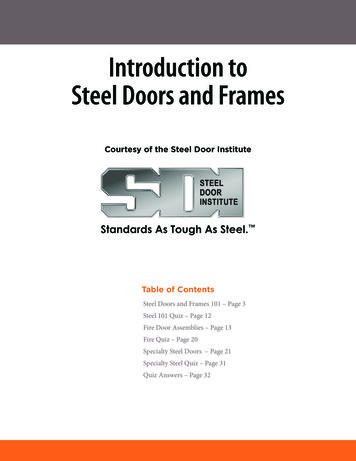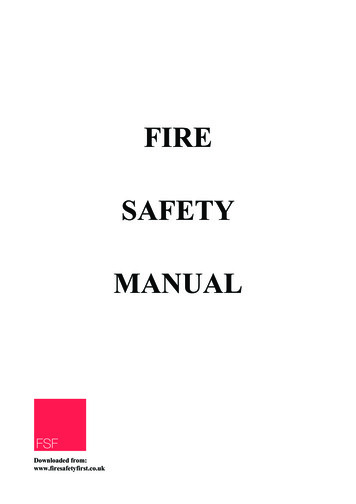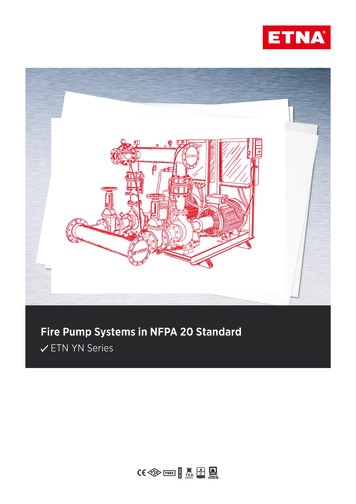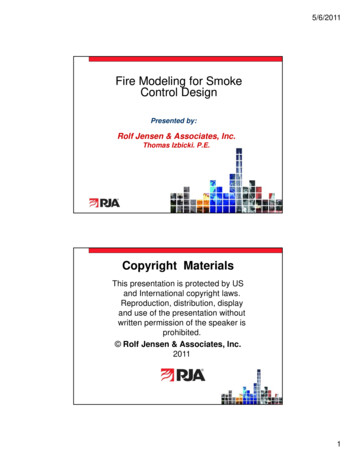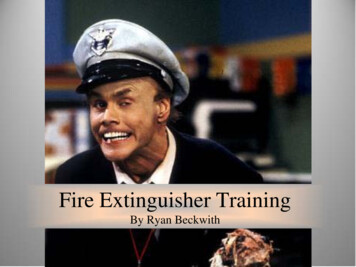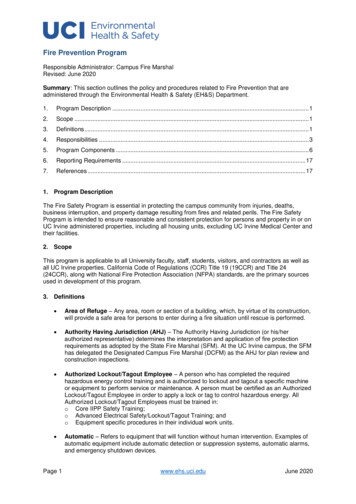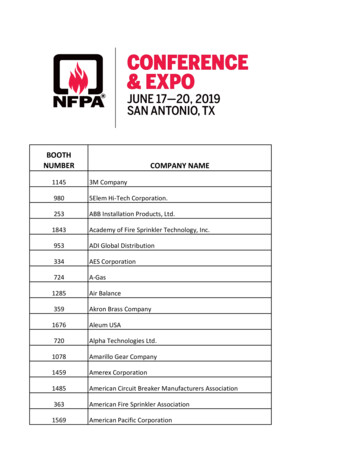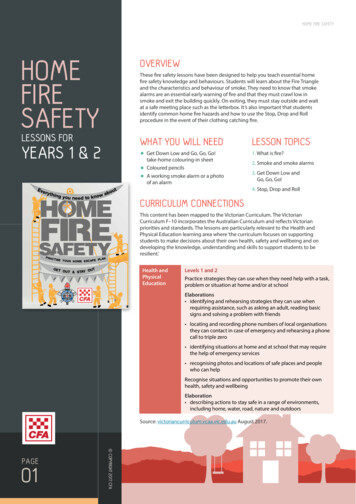
Transcription
HOME FIRE SAFETYHOMEFIRESAFETYOVERVIEWThese fire safety lessons have been designed to help you teach essential homefire safety knowledge and behaviours. Students will learn about the Fire Triangleand the characteristics and behaviour of smoke. They need to know that smokealarms are an essential early warning of fire and that they must crawl low insmoke and exit the building quickly. On exiting, they must stay outside and waitat a safe meeting place such as the letterbox. It’s also important that studentsidentify common home fire hazards and how to use the Stop, Drop and Rollprocedure in the event of their clothing catching fire.LESSONS FORWHAT YOU WILL NEEDYEARS 1 & 2Get Down Low and Go, Go, Go!take-home colouring-in sheetColoured pencilsA working smoke alarm or a photoof an alarmEveutrythaboing yowonu need to k2. S moke and smoke alarms3. G et Down Low andGo, Go, Go!4. S top, Drop and RollCURRICULUM CONNECTIONSSHealth RSAVALRKLYGGETTOUT & STAY OUONUT& STAY O1. What is fire?This content has been mapped to the Victorian Curriculum. The VictorianCurriculum F–10 incorporates the Australian Curriculum and reflects Victorianpriorities and standards. The lessons are particularly relevant to the Health andPhysical Education learning area where ‘the curriculum focuses on supportingstudents to make decisions about their own health, safety and wellbeing and ondeveloping the knowledge, understanding and skills to support students to beresilient.’PRACANTISE YOUR HOME ESCAPE PLWOPLANHOME ESCAPELESSON TOPICSLevels 1 and 2Practice strategies they can use when they need help with a task,problem or situation at home and/or at schoolElaborations identifying and rehearsing strategies they can use whenrequiring assistance, such as asking an adult, reading basicsigns and solving a problem with friendsOFFON locating and recording phone numbers of local organisationsthey can contact in case of emergency and rehearsing a phonecall to triple zero identifying situations at home and at school that may requirethe help of emergency services recognising photos and locations of safe places and peoplewho can helpRecognise situations and opportunities to promote their ownhealth, safety and wellbeingElaboration describing actions to stay safe in a range of environments,including home, water, road, nature and outdoorsSource: victoriancurriculum.vcaa.vic.edu.au August 2017.01 COPYRIGHT 2017 CFAPAGE
HOME FIRE SAFETYHOMEFIRESAFETYWHAT IS FIRE?20 MINUTES1. Draw and label the Fire Triangle on the board.Students can copy it down in their workbook.2. Explain that a fire needs these three thingsto burn: oxygen (air), fuel and heat. Tellthem when we talk about fuels for a fire wedon’t mean the liquids that run our cars –petrol, diesel or gas – though these thingscan certainly burn. Explain that fuel can bemany different things like paper or wood.Emphasise that all three things need to bepresent for a fire to start and continue burning.LESSONS FORYEARS 1 & 23. Explain that fire produces light, smoke and heat. Heat is invisible. You can onlyfeel it. You can see light (flame) and smoke. You can only smell smoke whenyou are awake. It’s very dangerous to breath in smoke.4. Ask students, ‘How do you put out a fire?’ Prompt them with options such as‘With water?’ or ‘What about covering it with a fire blanket?’ Remind themthat fire can be dangerous and adults should be the ones to put out a fire.5. Explain that a fire stops burning when one element of the triangle is removed.When water is used, it removes the heat and the fire stops. When fuel, such aspaper or wood is removed, the fire stops. When there is not enough oxygen(air), for instance when flame is covered with a fire blanket, the fire stops.SMOKE AND SMOKE ALARMS20 MINUTES1. Ask the students, ‘Who has seen smoke before?’ Then ask them to describewhat it looks, smells and tastes like. Explain that smoke is produced by fire.Smoke can be hot and it rises. It is also hard to see through and can sting youreyes. It smells and tastes horrible. When you breathe it in, it can make youcough.2. Explain that because heat and smoke rises, the air near the floor will be coolerand cleaner, making it easier to breathe.3. Show the students a working smoke alarm (or photo of an alarm). Ask them:‘How many of you know what this is?’‘Where have you seen them?’‘What are they used for?’4. Explain if they are asleep and a fire starts, they won’t be able to smell smoke.We need smoke alarms to wake us up.5. Ask students if they know what kind of sound a smoke alarm makes. Promptthem with options such as ‘Does it make a barking sound?’ or ‘Does it makethe same noise as a train?’6. If you have a working smoke alarm, ask students to cover their ears and pressthe test button to trigger the alarm (which is a high-pitched, and rapid, beepbeep-beep). Alternatively, you can show them a photo of a smoke alarm andan adult testing one. See below for examples:02 COPYRIGHT 2017 CFAPAGE
HOME FIRE SAFETYHOMEFIRESAFETYGET DOWN LOW AND GO, GO GO!20 MINUTES1. Ask students if they know what to do if they hear the smoke alarm, or see orsmell smoke. Explain that they should never hide from a fire or from the noiseof a smoke alarm. They can call for help but they must also crawl quickly out ofthe building.2. Explain how they should escape – Get Down Low and Go, Go, Go! Emphasisethat they should crawl low in smoke because the air is cooler and easier tobreathe. Invite a student to demonstrate as the class provides instructions onhow to Get Down Low and Go, Go, Go!LESSONS FOR3. They should crawl to the nearest door and feel it with the back of their hand.Explain that you must always use the back of your hand rather than the palm,as the back of your hand is more sensitive, especially to temperature. If thedoor is hot, there might be a fire on the other side. If this is the case, they needto find another exit, such as a window or another door. When they are outsidethe building, they should find a safe place to wait for help, such as the letterbox or front gate. They should never try to go back inside.YEARS 1 & 24. Encourage practice. Pair students up and have them take turns at performingthe Get Down Low and Go, Go, Go! procedure, while the other student talksthem through it.STOP, DROP AND ROLL20 MINUTES1. Explain to the students that clothing can easily catch fire if they are not a safedistance from an open flame or heat source. Explain that different materialsare made for different purposes, consider showing an example of a label onchildren’s pyjamas. A safe distance is at least one metre. Ask students, ‘Whatwould you do if your clothes caught on fire?’ Prompt them with optionssuch as ‘Would you run around to put out the flames?’ or ‘Would you blowon the flames?’ or ‘Stop, Drop and Roll?’2. Explain the Stop, Drop and Roll procedure below.If your clothes happen to catch fire, you should:STOP where you are immediatelyDROP quickly to the ground. Cover your face with your handsROLL back and forth to make sure all the flames on your clothing are outYou should then get help from an adult straight away to help cool the burnand get medical help.3. Have students pair up and take turns in giving the three-step instruction(Stop, Drop and Roll) whilst the other performs the action. Swap so that bothstudents get to perform each role.03 COPYRIGHT 2017 CFAPAGE
HOME FIRE SAFETYHOMEFIRESAFETYWRAP UPHand out copies of the Get Down Low and Go, Go, Go! colouring-in sheet forstudents to colour in and take home. Encourage them to discuss what they’velearned at home.They can ask their parents to:Clean the smoke alarm weekly, check the smoke alarm monthly, change thebattery in the smoke alarm yearlyHelp find two exits from every roomDecide where the safe meeting place will beWatch students practise Get Down Low and Go, Go, Go! and Stop, Drop and Roll.LESSONS FORYEARS 1 & 204 COPYRIGHT 2017 CFAPAGE
II,-FIRE SAFETY
Curriculum F–10 incorporates the Australian Curriculum and reflects Victorian . Source: victoriancurriculum.vcaa.vic.edu.au August 2017. 02 PAGE COPYRIGHT 201 CFA LESSONS FOR YEARS 1 2 HOME FIRE SAFETY HOME FIRE SAFETY WHAT IS FIRE? 20 MINUTES 1. Draw and label the Fire Triangle on the board.
